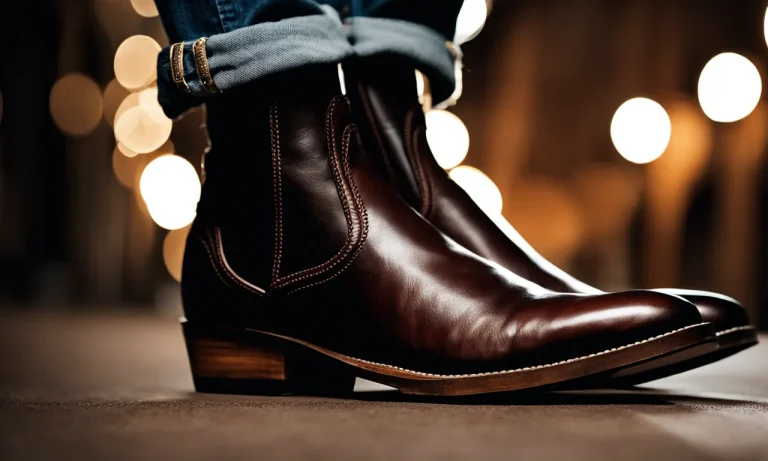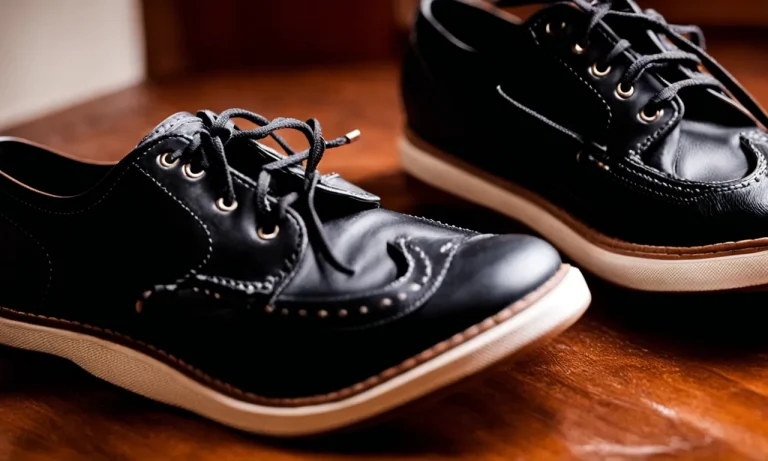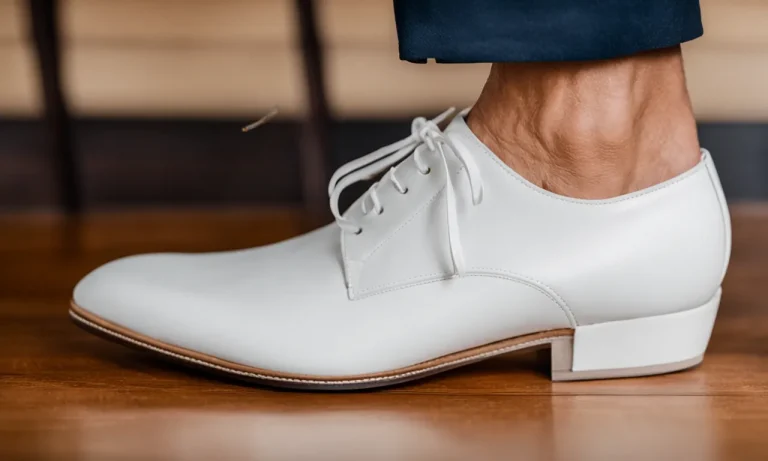Putting on and taking off boots, especially knee-high or thigh-high styles, can be a hassle. Lacing and unlacing tall boots takes time and effort. If you love the style of tall boots but dislike the process of getting in and out of them, consider adding zippers.
If you’re short on time, here’s a quick answer to your question: Adding zippers to boots involves carefully marking and cutting the fabric, inserting zippers, and neatly stitching around them for a clean look and smooth function.
In this comprehensive guide, we’ll cover everything you need to know about adding zippers to boots, from materials and tools needed to step-by-step instructions and tips for neat zipper installation.
Materials and Tools Needed
Fabric scissors
Fabric scissors are an essential tool for any sewing project, including adding zippers to boots. These scissors are designed to cut through fabric smoothly and accurately, making it easier to create clean and precise cuts.
Make sure to use a pair of fabric scissors that are sharp and in good condition to ensure the best results.
Seam ripper
A seam ripper is a handy tool that allows you to remove stitches without damaging the fabric. When adding zippers to boots, you may need to remove existing seams or stitches to make room for the zipper. A seam ripper will make this process much easier and help you avoid any accidental tears or snags.
Tailor’s chalk or fabric marker
Tailor’s chalk or a fabric marker will come in handy when marking the areas where you will be adding the zipper to your boots. These tools will allow you to make precise and visible markings on the fabric, ensuring that your zipper placement is accurate and symmetrical.
Zipper (as long as you want it)
Of course, you will need a zipper for this project. The length of the zipper will depend on the height or length of your boots. It’s always a good idea to choose a zipper that is slightly longer than necessary, as it can be trimmed down to fit perfectly.
Consider opting for a high-quality zipper that is durable and easy to open and close.
Zipper foot for your sewing machine
A zipper foot is a specialized sewing machine foot that allows you to sew close to the edge of the zipper tape. It provides better visibility and control, making it easier to stitch accurately and neatly. Make sure to attach the zipper foot to your sewing machine before starting the project.
Hand-sewing needle and thread
In addition to using a sewing machine, you may also need a hand-sewing needle and thread for some finishing touches. This will come in handy for securing the ends of the zipper and any other small details that require precise stitching.
Wonder tape or washable glue stick
Wonder tape or a washable glue stick can be used to temporarily hold the zipper in place before sewing. This will prevent the zipper from shifting or moving during the sewing process, ensuring that it stays aligned and centered.
These adhesive options are easy to remove and won’t leave any residue on the fabric.
Prepping the Boots
Decide on zipper placement
Before adding zippers to your boots, it’s important to decide on the placement. Consider factors such as where you want the zipper to start and end, as well as the size and style of the zipper. Take a look at your boots and determine the best location that will provide easy access for putting them on and taking them off.
Keep in mind that the placement may vary depending on the type and style of the boots you have.
Mark the fabric
Once you have decided on the placement, it’s time to mark the fabric. Using a fabric marker or chalk, carefully mark where the zipper will be sewn. Make sure to mark both the outside and inside of the boot so that you have a clear guide for sewing.
Take your time and double-check the markings to ensure accuracy before proceeding to the next step.
Carefully cut the fabric
With the markings in place, it’s time to carefully cut the fabric. Use a sharp pair of scissors or a utility knife to make a clean and precise cut along the marked lines. Take care not to cut too much or too little fabric, as this can affect the fit and functionality of the zipper.
Remember, it’s always better to cut a little less and make adjustments as needed.
Remove any existing closures like snaps or hooks
Before attaching the zipper, it’s important to remove any existing closures like snaps or hooks that may be in the way. Use a seam ripper or small scissors to carefully remove these closures, taking care not to damage the surrounding fabric.
This step will ensure a smooth and seamless attachment of the zipper to the boots.
Once you have prepped your boots by deciding on zipper placement, marking the fabric, cutting it carefully, and removing any existing closures, you are ready to move on to the next step of adding the zippers. Remember to take your time and work with precision to ensure a successful outcome.
Inserting the Zipper
Pin the zipper in place
Before you start inserting the zipper, make sure you have the right tools and materials handy. You’ll need a zipper, a zipper foot for your sewing machine, pins, and a fabric marker. Begin by aligning the zipper face down on the inside of the boot, making sure the teeth are centered along the seam.
Use the pins to secure the zipper in place, ensuring it stays straight and doesn’t shift while you sew.
Sew one side using a zipper foot
Once the zipper is pinned in place, it’s time to start sewing. Attach the zipper foot to your sewing machine and position the needle on the side where you want to start sewing. Slowly stitch along the edge of the zipper tape, removing the pins as you go.
Take your time to ensure a clean and straight stitch. Repeat the same process for the other side of the zipper.
Fold fabric over the zipper teeth
After you’ve sewn both sides of the zipper, fold the fabric over the teeth to create a clean finish. This will prevent the zipper from catching on any fabric or causing discomfort when wearing the boots.
Use your fabric marker to mark where the fabric should be folded over the teeth, and then carefully fold it over, making sure the teeth are completely covered.
Topstitch the second side by hand or machine
Next, it’s time to secure the folded fabric in place by topstitching. You can choose to do this by hand or with a sewing machine, depending on your preference and skill level. If you opt for hand stitching, use a strong thread and small, neat stitches.
If you decide to use a sewing machine, make sure to select a coordinating thread color and sew close to the edge of the fabric to ensure a secure stitch.
Secure the ends of the zipper
Finally, it’s important to secure the ends of the zipper to prevent it from unraveling or coming undone. You can do this by using a few simple techniques, such as folding the ends over and stitching them in place or using fabric glue to secure the fabric.
Whichever method you choose, make sure the ends are securely fastened to ensure the longevity of your newly added zipper.
Finishing Touches for a Polished Look
When it comes to adding zippers to boots for easy on and off, there are a few finishing touches that can make all the difference. These steps not only ensure that the zipper functions smoothly, but also contribute to a polished and professional look. Here are some important tips to consider:
Trim away excess fabric
Before attaching the zipper, it’s crucial to trim away any excess fabric around the opening. This helps to prevent bulkiness and ensures a clean appearance. By removing the excess fabric, the zipper will lay flat against the boot, allowing for easy zipping and unzipping.
Consider adding fabric reinforcement at stress points
In order to prolong the life of the zipper and prevent it from tearing or coming loose, it’s a good idea to reinforce the fabric at stress points. This can be done by adding additional layers of fabric or using reinforcement materials such as fusible interfacing.
By reinforcing these areas, you can increase the durability of the zipper and ensure it withstands regular wear and tear.
Cleanly stitch around the zipper opening
When sewing the zipper onto the boot, it’s important to stitch cleanly and accurately around the opening. This ensures that the zipper is securely attached and prevents any loose threads or fraying. By taking your time and using a strong and suitable thread, you can achieve a neat and professional finish.
Seam seal the zipper for waterproofing if needed
If you’re adding a zipper to boots that will be exposed to wet or damp conditions, it’s worth considering seam sealing for waterproofing. This involves applying a waterproof sealant along the stitching lines to prevent any water from seeping through.
It’s important to choose a seam sealant that is compatible with the fabric of the boot and follow the manufacturer’s instructions for best results.
By following these finishing touches, you can ensure that your zippers not only function smoothly but also contribute to a polished and professional look. Remember to take your time and pay attention to detail, and soon you’ll have boots with zippers that are both practical and stylish!
Conclusion
Adding zippers to boots allows for quick and easy on and off without sacrificing style. With the right materials, careful prep, and neat installation, you can upgrade your favorite boots with zippers. Take it slow, follow zipper installation best practices, and you’ll have stylish boots that are a cinch to get in and out of.
We hope this comprehensive guide gives you all the details you need to successfully add zippers to your boots. With some patience and practice, you can customize your boots for both fashion and function.






